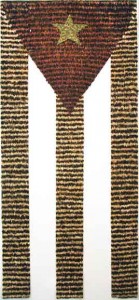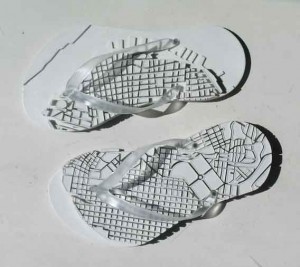« Reviews
Uprooted/Transmigrations
Pan American Art Projects - Miami
Curated by Abelardo Mena
The Trojan Horse: Displacement and Resilience of the Uprooted Nation
By Joaquín Badajoz
The history of humankind sometimes seem to be, without diminishing other complex axioms and principles of civilization, the tale of the agonic paradox between sedentariness and migration. The parallel narratives that, from one point of view, pile up as an act of cultural contraction around the cities and nations, and on the other hand, expand horizontally throughout human displacement-whether it be voluntarily or enforced. That is, in a nutshell, the dynamic between urbanites and nomadic values, intrinsically intertwined, which reproduce themselves out of the process of enculturation-the gradual acquisition of the characteristics and norms of the culture the subject is surrounded by-and the acculturation by which those different cultural features are interchanged via first hand contact. Despite that it is not a new topic, its validity is out of the question in a world that has not eradicated yet the most outrageous causes of transmigration: inhumane existence and political, religious, and ethnic persecution. Therefore, what seems worth questioning is not the migration by itself but the symbolic objectification of transmigration as a feature of identity between undeveloped and politically unstable societies.

Tania Bruguera, Estadística (Statistic), 1995-2000, collage with human hair, 108” x 60”. Photo Fernanda Torcida. All images are courtesy of the artists and Pan American Art Projects.
“Uprooted/Transmigrations,” curated by Abelardo Mena, curator of International Art at Museo de Bellas Artes in Havana, Cuba, which is on view at Pan American Art Projects in Miami from May 26 to July 30, 2011, focuses on this political side of the equation: “the Diaspora as one of the processes that integrate the identity (past and present) of American nations, at a time when most are celebrating bicentennials of their republics, which results from rebellion to colonial domination.”
The exhibition showcases thirty-two pieces by twenty-two important contemporary artists from the Americas whose approaches highlight either the diasporic phenomenon or the current debates about identity-some of them truly witnesses of cultural hybridism and hyphenated identity, as Cuban-Americans Luis Cruz Azaceta, Carlos Estévez, Carlos González, and Humberto Castro; or Haitian-American Edouard Duval-Carrié.
Argentineans Carlos Gallardo, Hernán Dompé, Yaya Firpo, and Graciela Sacco, explore the subject trough sculpture, collage, and object trouvé. Gallardo plays with memory as memorabilia, the tip of the iceberg of an intricate puzzle that appears as a source of psycho-emotional identity. In his pieces, from the series Evidencias (Evidences) and Desde Lejos (From Far Away), he uses the (re)collection as representation, manipulating old letters, photographs, envelopes, lead boxes, and wood boxes, creating packages that are treated as exhibits and testimonies of identity founded through migration, or as burdens of an uprooted/transplanted individual. Dompé’s mixed media sculptures, from his impressive series of ships, are excerpts of a zoomorphic sea fauna, which takes from the thesis that every near object is a mimesis of nature. Nature is then seen as a vessel or receptacle of identity. Yaya Firpo creates a new cartography, deconstructing and rebuilding maps that relocate Africa’s prairies and deserts in Europe-Kandahar in Seville and Cameron in Frankfurt: a metaphor of a reverse conquest. The displaced men, in Firpo’s imaginary, carry on their own cartography deep inside: transmigration never fades totally away the marks of origin tattooed in their bones. One of the most interesting pieces of this exhibition is Graciela Sacco’s artwork. Through heliography, an ancient photographic technique-the photography of the sun- Sacco reproduces human details or manmade objects over ordinary belongings, such as an old suitcase or a pair of shoes. In Sacco’s artwork, everything surrounding is a reflection of one’s self. Men’s souls are eventually transferred-in a sort of transmigration-to their belongings.
The Anglophone and Francophone Caribbean is represented in the artworks of Dr. David Boxter and the deceased Milton George-two important contemporary artists from Jamaica- and the prominent Haitian-American painter Edouard Duval-Carrié. George’s acrylic on canvas, Pomona, portrays an expressionist female figure in a nocturnal open space. The reddish and dark blue tints of the nightfall, the shadows and penumbra that surround the human shape give this piece a poetic connotation of abandonment and fake tranquility, the kind of isolation that can easily be associated with the natural condition of the islander. Boxter’s triptych, Passage (Black), despite its abstract nature, seems to be an allegoric message of the natural clash between words, colors, bodies, and blood, buried in a prominent layer, while, over this labyrinth of underground chaos, the dawn on the horizon moves forward. His second piece, Queen Victoria Set we free [sic], is an installation containing two collages of hundreds of stamps escorting an Afro-Caribbean idol, in a clear allusion to colonial domination and slavery as foundational stones of Jamaican identity.
Autel De L’Arbre Déraciné (Altar of the Uprooted Tree), by Duval-Carrié, a mixed media on canvas, remind us of the well-known poem Rite by Henry Dumas: “No power can stay the mojo when the obi is purple and the vodu is green and Shango is whispering, Bathe me in blood. I am not clean.” Obi/Obinna-God’s heart-is a votive offering tied to the neck of a tree, whose fruits are a half dozen hanging Christ’s flaming sacred heart. The encounter of beliefs, even the fusion among them, can only feed the aerial root tree that has become a metaphor of a transplanted nation founded upon the fighting against slavery and its legacy of bondage.
Fifteen Cuban artists complete the show. Most of them prominent artists, such as Luis Cruz Azaceta, a painter that embodies the tribulation of exile and “insile,” the voice of those postindustrial society nomads, “whom have no other alternative than to perpetuate their escapes from one world to another,” as Iván de la Nuez had said; Kcho, a vivid narrator of the Cuban rafters’ tragedy and arguably the most well-known artist of his generation; Sandra Ramos; Los Carpinteros; Tania Bruguera; Abel Barroso-presenting Double Identity, an interesting participative installation about the symbolic deterioration of the Cuban citizenship and the massive pursuit of freedom in a form of a foreign country passport, whether as an emotional game of reconciliation of their own roots or a mere way to escape from isolation; Humberto Castro; Santiago Olazábal, a Santeria priest and one of the artists that consistently focused on Afro-Cuban themes; Carlos Estévez; and sculptor Carlos González; as well as the lesser known or emergent, but with solid proposals: Jorge López Pardo, Alexis Acanda, Ernesto Javier Fernández Zalacain, and the The Merger (a collaborative venture by Niels Moleiro, Mario González, and Alain Pino).
As Heidegger once adverted, “all distances in time and space are shrinking,” insofar as the length of the voyage ends in a blink of an eye finding as well express gratification or death. From the title of this exhibition, it’s possible to assume transmigration not only in a physical sense of humane displacement, but as an inner representation of otherness in the otherness; a traveler’s condition of estrangement that can also be avoided from the perspective that frontiers and nations are historically determined. And therefore, at the end of this era there will only remain the cities and the voyager: and the art as depiction of the human trip.
(May 26 - July 30, 2011)
Joaquín Badajoz is and independent art critic and writer based in Miami.
Filed Under: Reviews




































